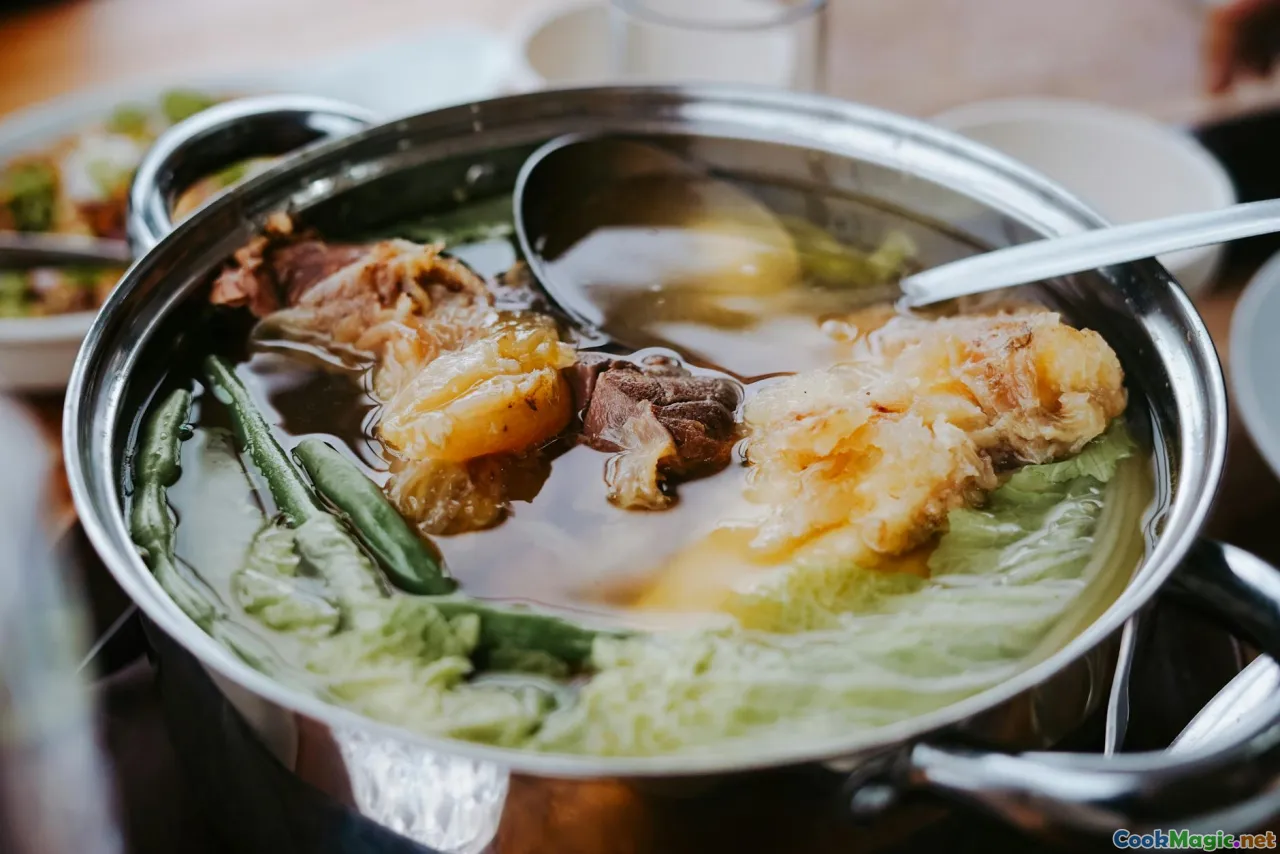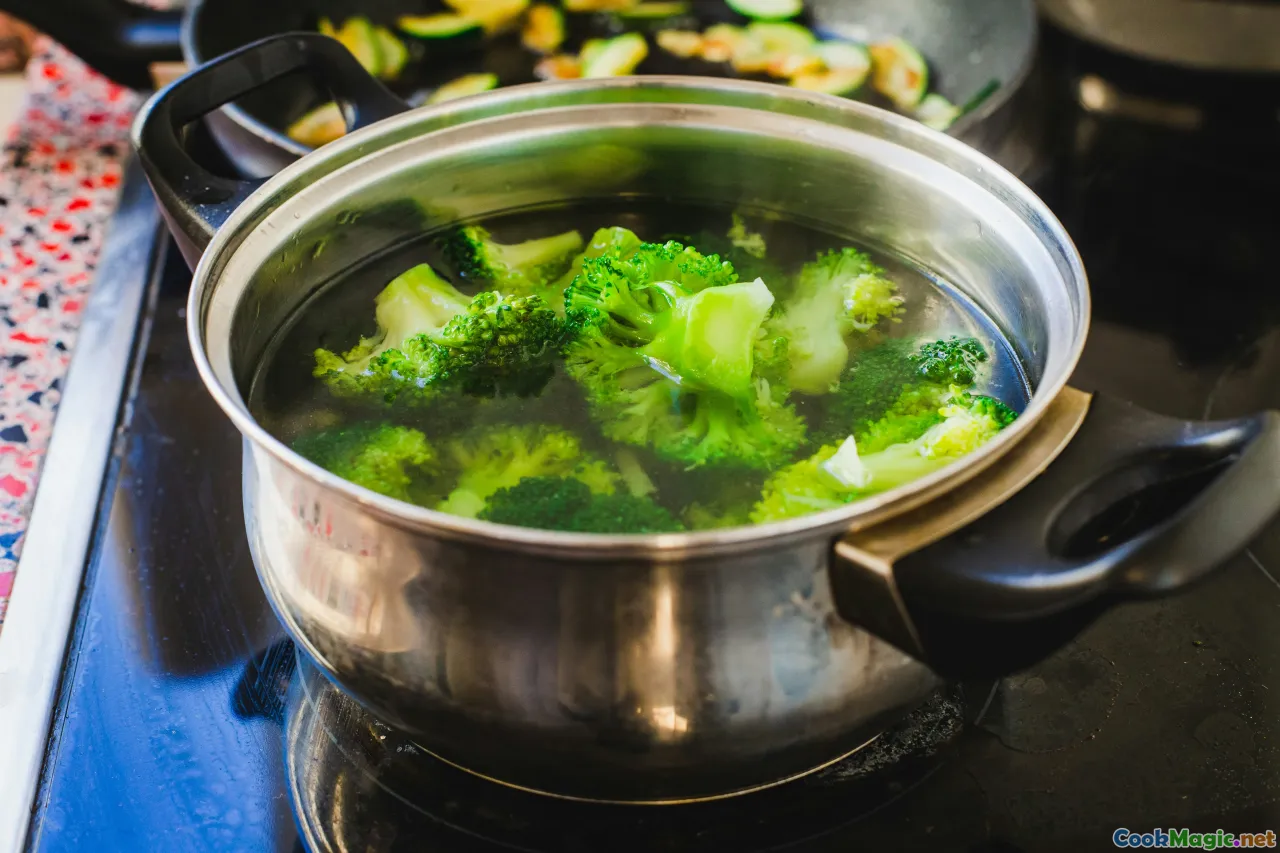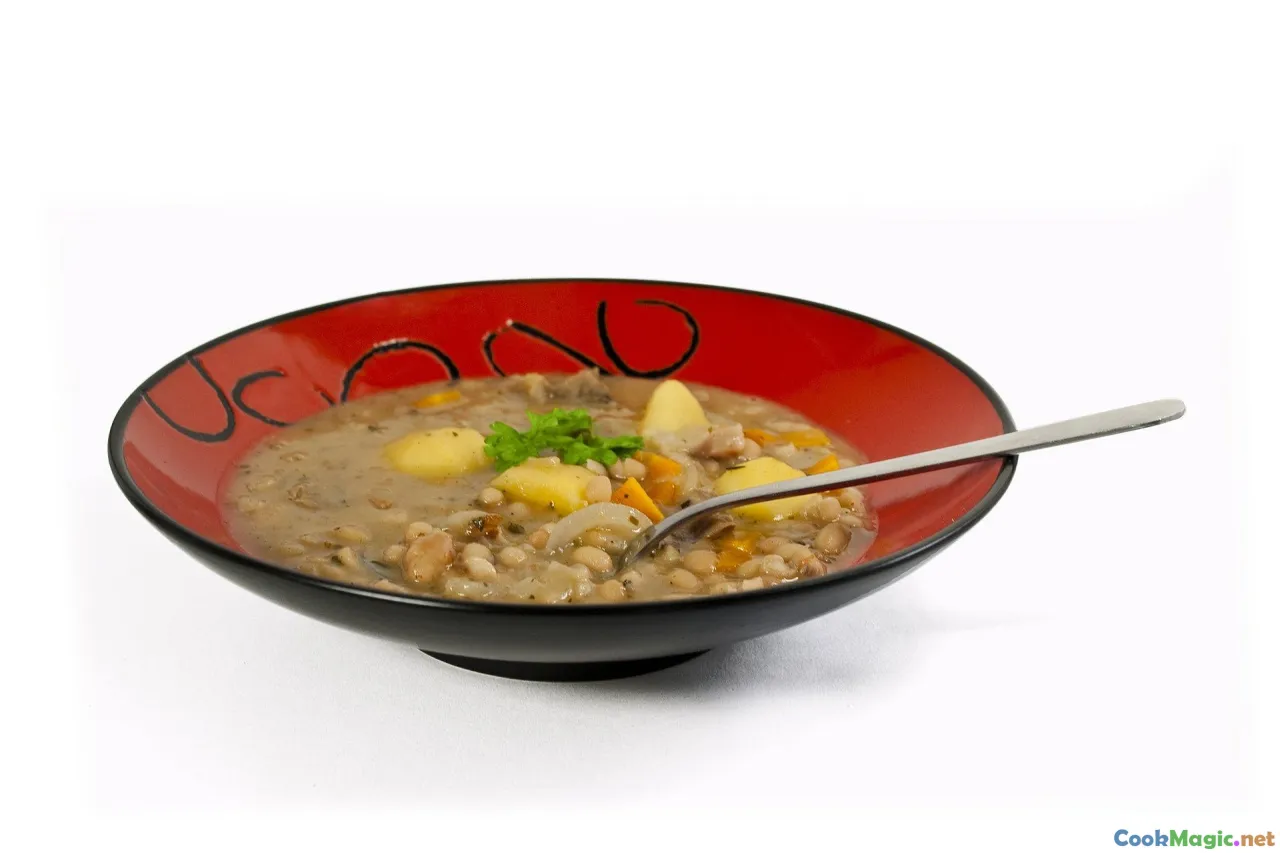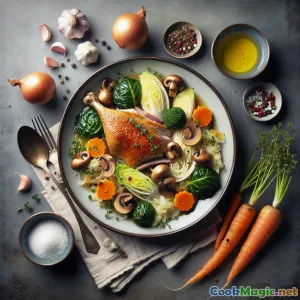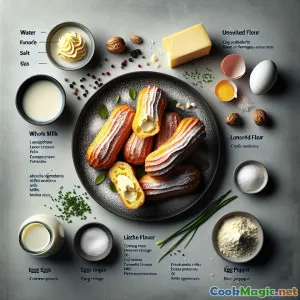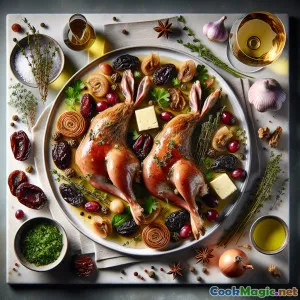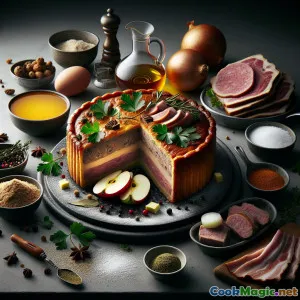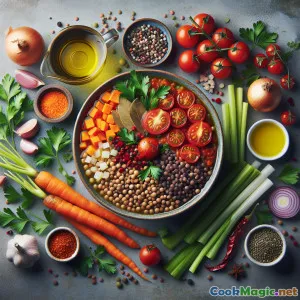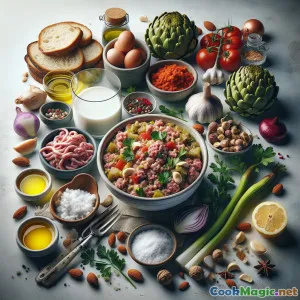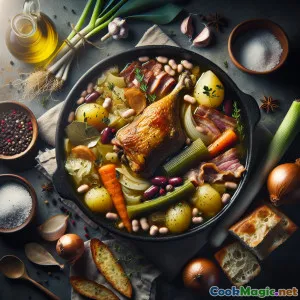
Stufato Rustico di Garbure Languedocienne: Anima della Campagna Francese
(Rustic Garbure Languedocienne Stew: French Country Soul)
(0 Recensioni)0
32
luglio 25, 2025
Segnala un problema
Ingredienti
-
2 legs Confitto di coscia d'anatra
(Can swap for ham hock for a different flavor)
-
150 grams Pancetta a fette spesse
(Unsliced slab preferred)
-
1/2 head Cavolo
(Green or Savoy, shredded)
-
250 grams Fagioli bianchi secchi
(Ammollato tutta la notte)
-
3 medium Carote
(Sliced into thick rounds)
-
2 whole Porri
(Cleaned, white and light green parts sliced)
-
3 medium Patate
(Pelato e tagliato a pezzi)
-
1 medium Rapa
(Peeled, diced)
-
1 large Cipolla
(A dadini)
-
4 cloves Spicchi d'aglio
(Tritato)
-
2 sprigs Timo
(Fresh preferred)
-
2 leaves Foglia di alloro
-
2 tbsp Prezzemolo fresco
(Tagliato finemente)
-
6 slices Pane rustico di campagna
(Per servire)
Pepe nero, To taste
Sale, To taste
-
2 tbsp Olio d'oliva
(Per saltare)
-
2.5 liters Acqua o brodo di pollo
(Enough to fully cover ingredients)
(Can swap for ham hock for a different flavor)
(Unsliced slab preferred)
(Green or Savoy, shredded)
(Ammollato tutta la notte)
(Sliced into thick rounds)
(Cleaned, white and light green parts sliced)
(Pelato e tagliato a pezzi)
(Peeled, diced)
(A dadini)
(Tritato)
(Fresh preferred)
(Tagliato finemente)
(Per servire)
(Per saltare)
(Enough to fully cover ingredients)
Nutrizione
- Porzioni: 6
- Dimensione Porzione: 1 ciotola (350g)
- Calories: 620 kcal
- Carbohydrates: 58 g
- Protein: 32 g
- Fat: 28 g
- Fiber: 14 g
- Sugar: 8 g
- Sodium: 942 mg
- Cholesterol: 82 mg
- Calcium: 94 mg
- Iron: 4.2 mg
Istruzioni
-
1 - Prepare the Beans:
Drain soaked beans. Add to a saucepan with fresh water and bring to a boil for 10 minutes. Drain and set aside.
-
2 - Render Bacon and Duck:
In a large Dutch oven, heat olive oil over medium. Add bacon and render until golden. Remove duck confit from excess fat, add to pot, and lightly brown both sides. Leave all in the pot.
-
3 - Sauté the Vegetables:
Add onion, leeks, and garlic to the pot. Sauté gently until softened and aromatic, about 8-10 minutes.
-
4 - Build the Stew Base:
Add carrots, turnip, potatoes, and cabbage to the pot. Stir for a few minutes until coated in aromatics.
-
5 - Add Liquids and Simmer:
Add par-cooked beans, thyme sprigs, bay leaves, and enough water or stock to cover generously. Season with salt and pepper. Bring to boil, cover, and simmer on low heat for 2 hours, stirring occasionally.
-
6 - Finishing Touches:
Uncover, skim any excess fat, remove thyme stems and bay leaves. Simmer until vegetables and beans are meltingly tender, about 30 more minutes.
-
7 - Serve:
Shred duck confit meat, remove bones, and return meat to stew. Ladle into bowls. Scatter parsley & extra pepper. Serve with slices of rustic bread.
Drain soaked beans. Add to a saucepan with fresh water and bring to a boil for 10 minutes. Drain and set aside.
In a large Dutch oven, heat olive oil over medium. Add bacon and render until golden. Remove duck confit from excess fat, add to pot, and lightly brown both sides. Leave all in the pot.
Add onion, leeks, and garlic to the pot. Sauté gently until softened and aromatic, about 8-10 minutes.
Add carrots, turnip, potatoes, and cabbage to the pot. Stir for a few minutes until coated in aromatics.
Add par-cooked beans, thyme sprigs, bay leaves, and enough water or stock to cover generously. Season with salt and pepper. Bring to boil, cover, and simmer on low heat for 2 hours, stirring occasionally.
Uncover, skim any excess fat, remove thyme stems and bay leaves. Simmer until vegetables and beans are meltingly tender, about 30 more minutes.
Shred duck confit meat, remove bones, and return meat to stew. Ladle into bowls. Scatter parsley & extra pepper. Serve with slices of rustic bread.
Ulteriori informazioni su: Stufato Rustico di Garbure Languedocienne: Anima della Campagna Francese
Garbure Languedocienne: A French Country Emblem of Comfort and Hearty Tradition
There are few dishes in French rustic cookery richer in tradition and warmth than Garbure, especially its Languedocienne interpretation from the sun-beaten southwest of France. Clustered between lush green valleys and medieval towns, this recipe is the living memory of a land formed by peasantry, emphasizing thrift, resourcefulness, and deep-rooted conviviality.
History & Cultural Significance
Garbure was born of rural ingenuity; it’s a hearty stew that embraces what’s available—from plump local beans to shreds of salt-cured duck confit or ham on cold winter days. Its roots trace back to the Middle Ages, when it was a daily meal for gascons (inhabitants of Gascony/Languedoc), wards off the regional chill with starchy vegetables and nutritional density. Historically, this was not a “given-recipe”: rather it evolved with the season, fields, and pantry, inseparable from French rural identity.
Every domaine or farmhouse customized its garbure, guided by earth’s generosity or scarcity. In the winelands of Languedoc, cabbage and turnips—aliments pauvres (humble, inexpensive ingredients)—were combined with leftover poultry, beans, and smoked or salted pork, slow-cooked for hours in a communal pot over embering kitchen fires. To serve, ancient tradition was to float a thick slice of stale bread in the bowl, soaking up aromatic juiciness—a tradition that lingers today and defines the dish’s unbeatable heartiness.
Unique Aspects
What sets "Garbure Languedocienne" apart? First, the use of duck confit imparts luxurious depth and silken texture through the slow gentle cooking. Secondly, chunky white beans lend a creamy backbone that absorbs, then mellows the pungency of smoked bacon and sautéed aromatics. While some garbures use “left-over” cuts, duck legs elevate this from peasant roots to French bistro staple.
Savoy cabbage (or green if more accessible) melts sweetly during the hours-long simmer, melding with carrots, leeks, and turnips—opposing the modern urge for crunch. Flavor is built over time, emerging from deep union rather than speedy searing. Bay and thyme conjure the aroma of an old French jardin, while parsley showered at serving cuts the richness cleanly.
Serving, Tips & Pairings
- Bread is Befitting: Don't skip the bread. Use artisan, thick-crusted country bread, left to stale slightly if you wish (the French spirit)! Float on top, or ladle stew over.
- Advance Preparation: Flavors intensify if cooked and left to cool/rest: Garbure rewarms beautifully, making it the perfect make-ahead meal for a gathering or cold weekend lunch.
- Wine Pairing: A hearty Languedoc red (Corbières or Minervois) is perfect; the stew’s depth welcomes bold syrah or grenache-based blends.
- Vegetarian Option: Omit the duck and bacon, load up on extra beans and root vegetables, and finish with a glug of best olive oil. The adaptation remains deeply nourishing.
Personal Reflections and Modern Adaptation
As a chef crafting experiences and not just instructions, Garbure delights me particularly for how its undertone isn’t just "taste"—but memory, warmth, family. In international or urban kitchens, beans are often overlooked for lavish cuts of meat; garbure flips that balance, showcasing legumes’ true potential. That it requires a long, slow bubbling works wonderfully in the age of pressure—and yields not just flavor, but homey contentment.
Of particular note is how flexible Garbure Languedocienne is. Swap the beans for lentils, or the duck for sausage suffices. Add whatever root veg survives in the winter bin. Kids can even help layer the vegetables for a family table experience. Endlessly variable, yet always deeply rooted in southern French sharing.
In Conclusion
Garbure Languedocienne is less a strict recipe, and more an invitation. Gather what the farm, store, or market has gifted. Sit, savor, and imagine yourself in the sweep of quiet Languedoc hills—where lunch brims with company, exactly as it should.

